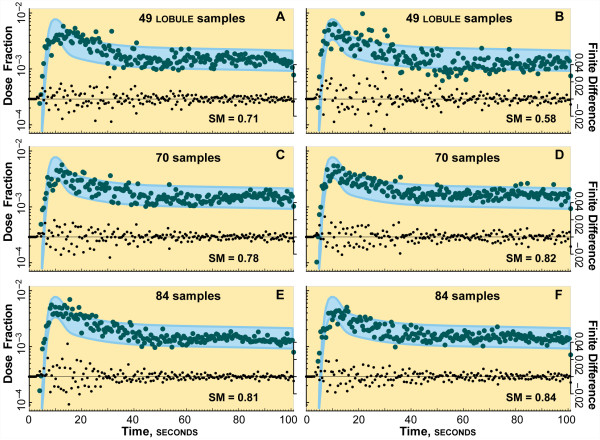Figure 4.
Cluster execution results. Shown are results from two ISL experiments on the eight-node, local cluster using 49, 70, 84, and 152 lobules. The fraction of the diltiazem dose collected at CV for each 0.5 s collection interval is plotted. A simulated profile (green circles) is acceptable if SM ≥ 0.8, i.e., ≥ 80% of values fall within the blue zone. An acceptable profile validates that ISL mechanism; an unacceptable profile falsifies it. The center of the zone corresponds to diltiazem blood levels, d [15]. The upper and lower bounds of the target zone are d ± σ/μ (coefficient of variation). σ/μ = 0.334 was calculated as described previously [1]. Smaller black dots are finite differences dn - dn-1; they show the extent to which the profile approaches an asymptote, amplifying periodic components. (A) shows a long period, exhibited by a local minimum at ~50 and a local maximum at ~80 s. (B) shows an oscillation with a local minimum at ~55 and a local maximum at ~95 s, and has the smallest SM value. Increasing lobule samples from 49 to 70 in (C) and (D) resulted in a less pronounced oscillation, reduced variance, and improved SM values. Increasing sample size to 84 in (E) and (F) achieved validation, yet there is still evidence of an oscillation, which is more prominent in (E). The finite difference profiles are better behaved than in (C) and (D). We hypothesize that, as the number of samples increases toward the number of lobules in a rat liver, the profile approaches an asymptote smoothly and oscillations disappear. The number of samples was chosen as integer factors of 7 to spread the samples evenly over the 7 slave nodes. 84 samples were the maximum for the local cluster before the memory footprint would cause machine faults.

